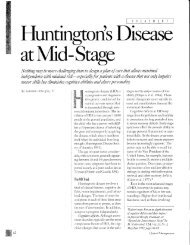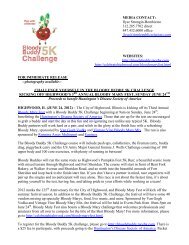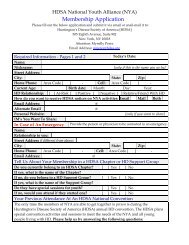The Marker - 2004 - Huntington's Disease Society of America
The Marker - 2004 - Huntington's Disease Society of America
The Marker - 2004 - Huntington's Disease Society of America
Create successful ePaper yourself
Turn your PDF publications into a flip-book with our unique Google optimized e-Paper software.
Renewing Fellowships<br />
2003-<strong>2004</strong><br />
Michael Cyr, Ph.D.<br />
Duke University<br />
Durham, NC<br />
Dopamine System and Its<br />
Contributing Role in the<br />
Development <strong>of</strong> Pathological<br />
Conditions in Huntington’s <strong>Disease</strong><br />
Lac Djousse, M.D.<br />
Boston University School <strong>of</strong> Medicine<br />
Boston, MA<br />
A Genome Scan for Genetic<br />
Modifiers <strong>of</strong> Huntington’s <strong>Disease</strong><br />
HDSA <strong>The</strong>rapeutic<br />
Initiative<br />
Steven M. Finkbeiner, M.D., Ph.D.<br />
Gladstone Institute <strong>of</strong> Neurological<br />
<strong>Disease</strong><br />
San Francisco, CA<br />
PolyQ Conformation-Based Drug<br />
Screen<br />
Susan Lindquist, Ph.D.<br />
Whitehead Institute for Biomedical<br />
Research<br />
Boston, MA<br />
Yeast as a Model System for<br />
Huntingtin-Mediated Toxicity<br />
HDSA <strong>The</strong>rapeutic<br />
Initiative<br />
Nancy Muma, Ph.D.<br />
Loyola University<br />
Chicago, IL<br />
<strong>The</strong>rapeutic Targeting <strong>of</strong><br />
Transglutaminase for <strong>Huntington's</strong><br />
<strong>Disease</strong><br />
James Gusella, Ph.D. and<br />
Marcy MacDonald, Ph.D.<br />
Massachusetts General Hospital<br />
Charlestown, MA<br />
PROMPT ASSAY<br />
Christopher A. Meade, Ph.D.<br />
University <strong>of</strong> Tennessee<br />
Memphis, TN<br />
Does Cortex Kill Striatum in HD? A<br />
Study Using in Oculo Co-Implants<br />
GLOSSARY<br />
Aggregation: the clumping <strong>of</strong> proteins in<br />
cells that interfere with cell functioning;<br />
aggregation <strong>of</strong> the huntingtin protein is<br />
seen in HD.<br />
Caspase: an enzyme that induces cell<br />
death (apoptosis).<br />
Cleavage: the degradation <strong>of</strong> a large,<br />
complex molecule into a smaller one;<br />
cleavage is one example <strong>of</strong> a posttranscriptional<br />
modification and can be<br />
used to alter the activity <strong>of</strong> a protein.<br />
CNS (central nervous system): <strong>The</strong><br />
central nervous system is the portion<br />
<strong>of</strong> the nervous system that includes the<br />
brain and the spinal cord. It is through<br />
this region that the brain sends signals<br />
to the rest <strong>of</strong> the body.<br />
Conformational Changes: when a protein<br />
changes structure.<br />
Gene Transcription: before a gene<br />
becomes a protein, it must go through<br />
several processes. <strong>The</strong> first step is<br />
called gene transcription and it occurs<br />
when a gene is transcribed into RNA<br />
using nucleic acids.<br />
Huntingtin: the protein encoded by<br />
the gene that carries the HD defect.<br />
Repeated CAG regions in the gene<br />
cause an abnormal form <strong>of</strong> huntingtin<br />
to be produced.<br />
Organelles: subunits within cells that<br />
carry out a specific function; mitochondria,<br />
for example, are the organelles<br />
that create usable energy for a cell.<br />
Pathogenesis: the development and<br />
progression <strong>of</strong> disease.<br />
Phosporylation: the addition <strong>of</strong> phosphates<br />
to a protein; phosporylation is<br />
one example <strong>of</strong> a post-translational<br />
modification and can be used to alter<br />
the activity <strong>of</strong> a protein.<br />
Post-translational Modifications: after a<br />
gene is translated into a protein it may<br />
undergo a variety <strong>of</strong> alterations. <strong>The</strong>se<br />
changes, collectively referred to as<br />
post-translational modifications, alter<br />
the functionality <strong>of</strong> a protein, sometimes<br />
enabling it to work, other times marking<br />
the protein for degradation.<br />
Proteomics: the study <strong>of</strong> proteins and<br />
their function.<br />
Ribonucleic Acid (RNA): RNA serves as<br />
the intermediary between DNA and<br />
proteins. DNA is stored in the nucleus,<br />
the organelle frequently referred to as<br />
the “brains” <strong>of</strong> the cell, while the<br />
machinery needed to produce proteins<br />
remains in the cytoplasm. <strong>The</strong> cell relies<br />
on RNA to carry the DNA instructions<br />
from the nucleus into the cell’s<br />
cytoplasm.<br />
Signaling Pathway: when a cell needs<br />
to send a message to the nucleus (the<br />
“brain” <strong>of</strong> the cell where the genes are<br />
located), it must go through a series <strong>of</strong><br />
events, much like a dominos game.<br />
This cascade <strong>of</strong> messages is called a<br />
signaling pathway.<br />
Transcription Regulation: cells require<br />
different proteins depending upon their<br />
stage <strong>of</strong> development. As a result, cells<br />
will vary which genes undergo transcription<br />
(see gene transcription) at different<br />
times and this process is known as<br />
transcription regulation.<br />
6

















